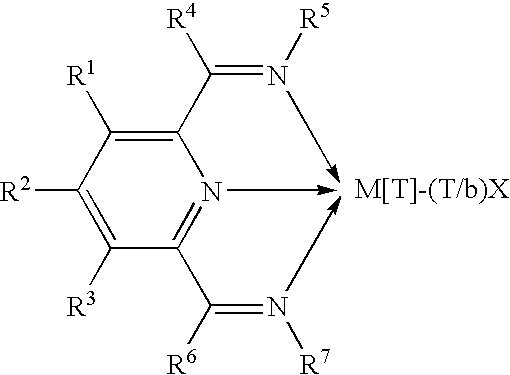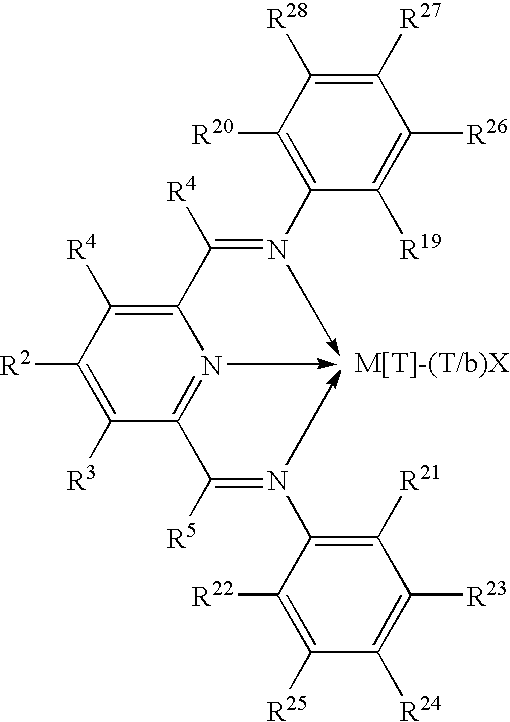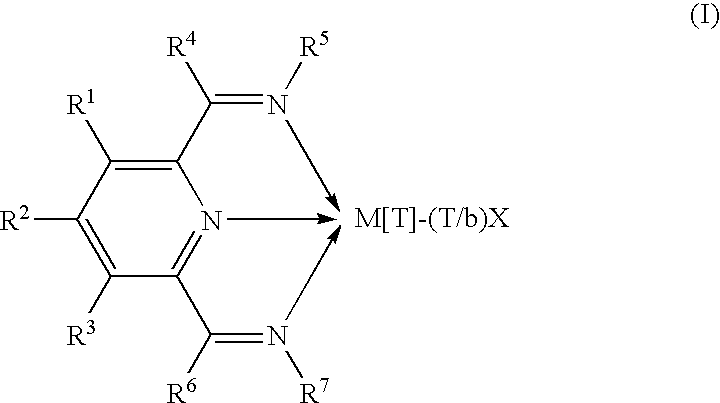Olefin polymerization catalysts, their synthesis and use
a polymerization catalyst and polymerization technology, applied in the field of olefin polymerization catalysts, can solve the problems of high impurity sensitivity, high cost, and frequent use of metallocene catalysts to achieve high activity
- Summary
- Abstract
- Description
- Claims
- Application Information
AI Technical Summary
Benefits of technology
Problems solved by technology
Method used
Image
Examples
synthesis example 1
Catalyst Synthesis Example 1
[0082]DEAC-757 (45 g) was slurried in 300 mls of toluene and reacted with [Ph3C][B(C6F5)4] (6 g) for 10 min at ambient temperature. Fe compound III (3 g) was added and the reaction mixture stirred for 12 hr. The resulting solid was filtered and washed with hexane and dried in vacuo. The catalyst was yellow-orange in color.
synthesis example 2
Catalyst Synthesis Example 2
[0083]DEAC-757 (2.0 g) was slurried in 30 mls of toluene and reacted with 2,6 bis[1-(2-tolylphenylimine)ethyl]pyridine iron dichloride (0.2 g) for 10 min at ambient temperature. [Ph3C][B(C6F5)4] (0.3 g) was then added and the mixture was stirred for 20 min. The supported catalyst was filtered, washed with hexane and dried in vacuo to yield a bright orange solid.
Catalyst Synthesis Example A (Comparative)
[0084]2,6 Bis[1-(2,6-dimethylphenylimine)ethyl]pyridine iron dichloride (36 mg) was slurried in 30 ml toluene. 2 g of SMAO-757 was added and the mixture stirred for 2 hr. The catalyst was filtered, washed with hexane and dried in vacuo for 4 hr. A tan colored free flowing solid was obtained.
synthesis example b (comparative)
Catalyst Synthesis Example B (Comparative)
[0085]2,6 Bis[1-(2,6-dimethylphenylimine)ethyl]pyridine iron dichloride (36 mg) was slurried in 30 ml toluene. TEAL-757 (2.0 g) was added and the mixture stirred for 2 hr. The catalyst was filtered, washed with hexane and dried in vacuo for 4 hr. A light green solid was obtained.
PUM
| Property | Measurement | Unit |
|---|---|---|
| temperature | aaaaa | aaaaa |
| temperature | aaaaa | aaaaa |
| polydispersity index | aaaaa | aaaaa |
Abstract
Description
Claims
Application Information
 Login to View More
Login to View More - R&D
- Intellectual Property
- Life Sciences
- Materials
- Tech Scout
- Unparalleled Data Quality
- Higher Quality Content
- 60% Fewer Hallucinations
Browse by: Latest US Patents, China's latest patents, Technical Efficacy Thesaurus, Application Domain, Technology Topic, Popular Technical Reports.
© 2025 PatSnap. All rights reserved.Legal|Privacy policy|Modern Slavery Act Transparency Statement|Sitemap|About US| Contact US: help@patsnap.com



